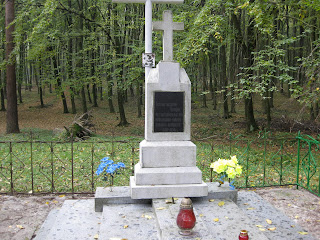From the cemetery, we headed off to the forest to find the monuments to Jews and Ukrainians who were mass-murdered there (by the Nazis and Soviets, respectively). At one point at the end of WWII, Stalin ordered all of the prisoners being held in nearly prisons to be executed rather than having them repatriated as Soviet citizens. The entrance to the forest was across the street from a church, and the path to the monuments was a procession route for the stations of the cross.
 |
| Monument to Jewish victims |
 |
| Monument to Ukrainian victims |
 |
| the two monuments side by side |
After leaving the forest, we set to try to find my grandfather's village. Alex had a map and suggested we stop in some villages that were about 4 km away from Peremyshliany, and ask the oldest lady in town if she remembered a family named Schechter that had once operated a dairy farm. It seemed like a far-fetched plan to me, but since I didn't have any better suggestions, I didn't object. So we drove out to a tiny village called
Vypysky. We drove up to a lady, who pointed us to a home where an 85-year-old woman lived. We drove up to the home, and Alex asked the man who was out in the yard if we could come in and talk to the woman. He agreed, so we knocked on the door and an old lady answered. It turns out that she
did remember a Jewish family called Schechter that had a dairy farm!
She noted that their house was no longer standing, but pointed to the spot where it was located. We thanked her and followed her directions and found and found an empty field. Around the bend in the road, it looked like there were some farm buildings, so we went to investigate. There were some people working, and they told us that the farm was built during the Soviet era. There was also a decaying stable, which Alex thought looked too new.
 |
| stable |
On our way back to the car, we saw an elderly lady walking down the road. So, Alex went to ask her as well. She excitedly told us that her parents talked about a Jewish family that had a dairy farm, and that her husband mentioned that he had played with a Jewish girl from that family when he was a child. She even pointed to the same place the first woman had when we asked her if she knew where their house had been. She seemed to happy to share this information, and became bashful when my dad asked her if he could take her photo.

When my dad heard her confirm the first woman's story, he said that he got goosebumps. We drove back up the road to the site. Although there was nothing to indicate the presence of a house or any farm buildings, we did find a raised spot in the ground that might have been part of a foundation. also, the surrounding plots of land (one was across the road and down an incline, and another was up a hill) were both flat and could very well have been a pasture. While we can't guarantee with certainty, it seems as though this spot was where my grandfather was born, lived and worked with this family, milking cows and delivering milk, until he was 19 years old and he emigrated to the United States to start a business (with his older brother Nathan) and a family (with my grandmother, Elaine).
 |
probable location of our old family home
Тут будинок мого діда можливо колись стояв. |
 |
| Harold in the pasture |









This really is mindblowing. I love the pictures of the ladies!
ReplyDelete